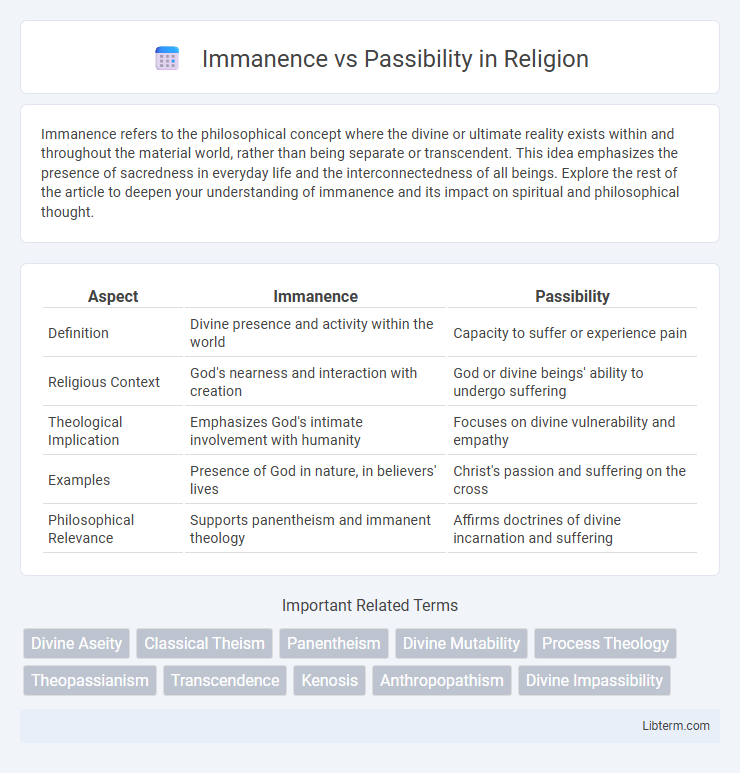Immanence refers to the philosophical concept where the divine or ultimate reality exists within and throughout the material world, rather than being separate or transcendent. This idea emphasizes the presence of sacredness in everyday life and the interconnectedness of all beings. Explore the rest of the article to deepen your understanding of immanence and its impact on spiritual and philosophical thought.
Table of Comparison
| Aspect | Immanence | Passibility |
|---|---|---|
| Definition | Divine presence and activity within the world | Capacity to suffer or experience pain |
| Religious Context | God's nearness and interaction with creation | God or divine beings' ability to undergo suffering |
| Theological Implication | Emphasizes God's intimate involvement with humanity | Focuses on divine vulnerability and empathy |
| Examples | Presence of God in nature, in believers' lives | Christ's passion and suffering on the cross |
| Philosophical Relevance | Supports panentheism and immanent theology | Affirms doctrines of divine incarnation and suffering |
Understanding Immanence: A Brief Overview
Immanence refers to the inherent presence and activity of a divine or essential force within the material world, emphasizing that everything exists within this intrinsic reality. It contrasts with passibility, which deals with susceptibility to suffering or change, highlighting the capacity to be affected externally. Understanding immanence involves recognizing that the divine or ultimate reality is not separate from creation but is actively internal and interconnected with all aspects of existence.
Defining Passibility: Key Concepts
Passibility refers to the capacity of a being or entity to experience suffering, change, or affectivity, highlighting its openness to external influences and emotional responsiveness. In theological and philosophical contexts, passibility contrasts with impassibility, where impassibility denotes freedom from suffering or emotional disturbance. Understanding passibility involves exploring concepts of vulnerability, receptivity, and the dynamic nature of existence in relation to external factors and internal experiences.
Historical Perspectives: Immanence and Passibility in Philosophy
Historical perspectives on immanence and passibility explore the tension between divine presence within the world and the capacity to experience suffering or change. Philosophers like Spinoza emphasized immanence as God's inherent existence within all things, rejecting transcendence, while thinkers such as Aquinas grappled with passibility in the context of divine impassibility and Christ's dual nature. This discourse influenced theological and metaphysical debates on how divinity interacts with human experience and the cosmos.
Immanence in Theology: Divine Presence and Action
Immanence in theology emphasizes the intimate presence and active involvement of the divine within the world, manifesting God's closeness to creation through continuous interaction and sustaining power. This concept highlights that God is not distant or detached but inherently present in all aspects of existence, enabling a dynamic relationship between the divine and humanity. Theological immanence contrasts with passibility by affirming God's unchanging nature and ongoing engagement without suffering or external influence.
Passibility and the Nature of Divine Emotion
Passibility, as understood in theological discourse, refers to the capacity of the divine to experience emotion, suffering, and change, contrasting with classical notions of divine impassibility that depict God as unaffected by temporal events. This concept redefines the nature of divine emotion by affirming that God is not a distant, unchanging presence but actively responsive and empathetic to creation's pain and joy. The acceptance of passibility challenges traditional metaphysical boundaries, emphasizing a dynamic and relational understanding of the divine nature.
Key Differences: Immanence vs Passibility
Immanence refers to the inherent, indwelling presence of a divine or essential quality within a being or system, emphasizing continuity and self-sufficiency. Passibility, contrastingly, denotes the capacity to suffer, change, or be affected by external forces, highlighting vulnerability and responsiveness. The key difference lies in immanence's focus on internal permanence versus passibility's emphasis on external influence and transformation.
Immanence and Passibility in Religious Traditions
Immanence in religious traditions refers to the divine presence existing within the universe and all aspects of life, highlighting God's intimate involvement with creation. Passibility denotes the capacity of a deity to experience suffering or change, often contrasting with divine impassibility, which asserts God's transcendence and immutability. The interplay between immanence and passibility shapes theological understandings of God's relationship with humanity, as seen in Christianity's emphasis on Jesus Christ's suffering (passibility) and presence in believers (immanence).
Contemporary Debates: Theological Implications
Contemporary debates on Immanence vs Passibility center on the nature of divine interaction with suffering and change, emphasizing how God's immanence relates to presence within creation amid human pain. Theological implications explore whether divine passibility implies God's capacity to be affected by temporal events, challenging classical views of divine impassibility and prompting re-evaluations of God's relationality and empathy. These discussions influence pastoral theology and doctrines of providence by addressing how God experiences and responds to human suffering in a dynamic, immanent manner.
Practical Applications: Immanence and Passibility in Spiritual Life
Immanence in spiritual life emphasizes the divine presence within the individual, encouraging personal growth through mindfulness, meditation, and inner reflection. Passibility highlights the acceptance of suffering and vulnerability, fostering empathy, compassion, and resilience by embracing human limitations. Practical applications include integrating immanence through daily spiritual practices and embracing passibility by cultivating emotional openness and spiritual endurance during challenges.
Conclusion: Evaluating Immanence and Passibility in Modern Thought
Immanence emphasizes the inherent presence and activity within entities, framing existence as self-sustained and dynamically interconnected, whereas passibility highlights the capacity to be affected or changed by external forces. Modern thought increasingly integrates these concepts, recognizing that genuine being involves both autonomous agency and receptive vulnerability. Evaluating immanence and passibility together enriches philosophical discourse by balancing self-contained vitality with openness to transformation and influence.
Immanence Infographic

 libterm.com
libterm.com